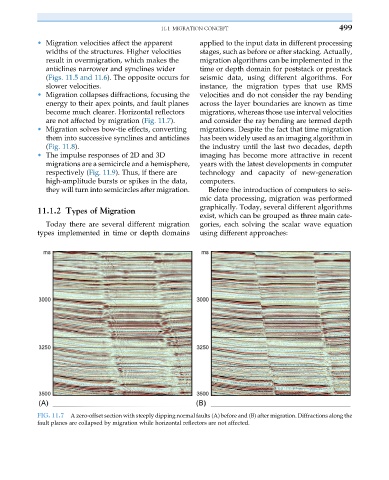Page 508 - Acquisition and Processing of Marine Seismic Data
P. 508
11.1 MIGRATION CONCEPT 499
• Migration velocities affect the apparent applied to the input data in different processing
widths of the structures. Higher velocities stages, such as before or after stacking. Actually,
result in overmigration, which makes the migration algorithms can be implemented in the
anticlines narrower and synclines wider time or depth domain for poststack or prestack
(Figs. 11.5 and 11.6). The opposite occurs for seismic data, using different algorithms. For
slower velocities. instance, the migration types that use RMS
• Migration collapses diffractions, focusing the velocities and do not consider the ray bending
energy to their apex points, and fault planes across the layer boundaries are known as time
become much clearer. Horizontal reflectors migrations, whereas those use interval velocities
are not affected by migration (Fig. 11.7). and consider the ray bending are termed depth
• Migration solves bow-tie effects, converting migrations. Despite the fact that time migration
them into successive synclines and anticlines has been widely used as an imaging algorithm in
(Fig. 11.8). the industry until the last two decades, depth
• The impulse responses of 2D and 3D imaging has become more attractive in recent
migrations are a semicircle and a hemisphere, years with the latest developments in computer
respectively (Fig. 11.9). Thus, if there are technology and capacity of new-generation
high-amplitude bursts or spikes in the data, computers.
they will turn into semicircles after migration. Before the introduction of computers to seis-
mic data processing, migration was performed
graphically. Today, several different algorithms
11.1.2 Types of Migration
exist, which can be grouped as three main cate-
Today there are several different migration gories, each solving the scalar wave equation
types implemented in time or depth domains using different approaches:
FIG. 11.7 A zero-offset section with steeply dipping normal faults (A) before and (B) after migration. Diffractions along the
fault planes are collapsed by migration while horizontal reflectors are not affected.

